My Egyptian Art Gallery
![]()
This may take a little bit to load, so you may want to go make a fresh pot of coffee and get a made from scratch danish.
My Egyptian Art Gallery
![]()
This may take a little bit to load, so you may want to go make a fresh pot of coffee and get a made from scratch danish.
 |
This is the front of the Narmer Palette, which shows the unification of the Two Lands. On it you can see King Narmer smiting his enemy, his sandal bearer is standing directly behind him. The top register shows a serakh, which is a palace facade with the pharaohs name in it, in this case Narmer. These were used before cartouches. The bottom register shows some trampled enemies. |
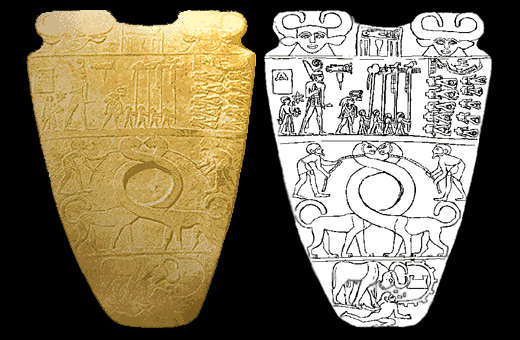 |
This is the other side of the Narmer Palette. This is the side that would have been used for the grinding of kohl to line the King's eyes. In the top register is the serakh with Narmers name between the heads of the goddess Hathor. The next register shows Narmer following the standard bearers representing various nomes. The intertwined beasts in the third register symbolize the unification of Upper and Lower Egypt. The bottom register shows Narmer as a bull, trampling his enemies, a theme that became very popular in Pharaonic Egypt. |
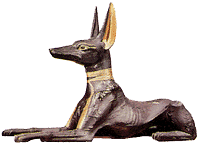 |
Anubis was god of the dead in early Egyptian religion, but was superseded by Osiris early in the Old Kingdom. He then became one of the gods of the funerary cult, and god of cemeteries. He helped to protect the dead. He presided over the weighing of the deceased's heart to determine if they were worthy of continuing on, and if their heart was lighter than Ma'at, he walked them to Osiris to begin their journey through the underworld. |
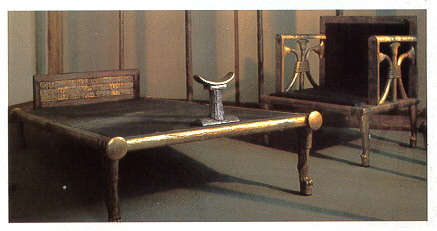 |
This furniture was found in a tomb next to the Great Pyramid of Giza. It belonged to Hetepheres, the Great Royal Queen of Snefru and mother of Khufu. Her tomb had been plundered while Snefru still ruled, and Khufu had a new one built next to his pyramid. When modern Egyptologists found her second tomb it had been closed for almost 4,000 years. Unfortunately, her body was never discovered. It has been suggested that the priest who buried her the second time knew that she was not in her sarcophagus, but were unwilling to anger the Pharaoh Khufu. It is thought that this room was used for traveling, as the walls could be taken part and put together again at a moments notice. |
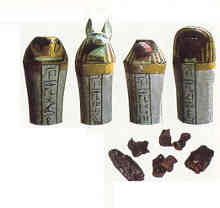 |
Although her body was never found, the canopic jars used to hold the remains of Hetepheres were still in her tomb when opened by modern day Egyptologists. |
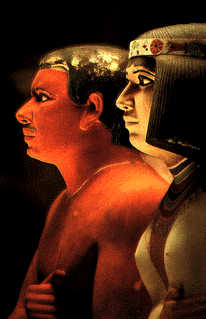 |
Here is Rhahotep and his wife Nofret as they stare into eternity. The statues are life size and incredibly life like. Their eyes are made of glass paste and Nofret even has curls of 'real' hair painted on to just peek out from under her wig. They had lain undisturbed for thousands of years until they were discovered still sitting as they had been left when Rhahotep and Nofret died in the Fourth Dynasty. |
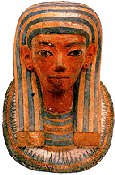 |
I found this on the internet somewhere, but have never been able to find out where it came from or who it is supposed to be. But it is a lovely work of art crafted for the journey to the underworld. |
 |
The Ancient Egyptians thought the world of the dead was much like the world of the living. A person was expected to perform his share of work in the afterlife. Starting around the Middle Kingdom, ubshatis, or shawabtis, were often placed in the tomb of the deceased to perform the work he was expected to do in the afterlife. The ubshati would 'answer' for the deceased when his name was called to perform his work. They were most commonly made of faience, a quartz paste that was molded and fired, but wood, stone and terra cotta ubshatis were also common. |
 |
This is the goddess Hathor and the pharaoh Seti I from his tomb in The Valley of the Kings. |
 |
A mummy covering constructed of painted and pasted cloth from about 800 B.C.E. |
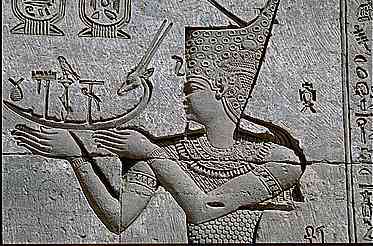 |
A relief from the Temple of Denderah, during Ptolemaic times in the first century B.C.E. |
 |
The Ancient Egyptians believed that the body consisted of many spiritual parts. One of the these was the Ka. The Ka was the spiritual double of the person, as well as his conscience bringing him to do good and be kind and compassionate. Sin and evil were an 'an abomination of the ka' and death was often seen as 'going to one's Ka.' The Ka was symbolized by the up-raised arms shown on this statue. The Ka could only live as long as it had a place to reside in, hence the need for mummification. Often statues were also used for a residence for the Ka. |
 |
The Egyptians considered the Ba another part of the body. It was usually represented by a human headed bird. The wings folded over a mummy case are also a representation of the the Ba. The Egyptians thought of the Ba as the soul, spirit or spiritual manifestation |  |
 |
The Ancient Egyptians believed that when they died, their heart was weighed against Ma'at, or the Feather of Truth. If their heart was lighter than Ma'at, they were allowed to enter the underworld, if not, their heart was devoured and they ceased to exist in any world. This is a 'heart scarab' that was placed over the heart of the deceased to be weighed against Ma'at. They were often inscribed with a spell which entreated the heart not to 'stand as a witness against me.' |
 |
Hatshepsut is a very well known pharaoh, for as far as we know, she was the only woman to rule as pharaoh in her own right. Women were given high status in Ancient Egypt, as long as they kept their place. A man could not become pharaoh unless he married the eldest daughter of the pharaoh, the blood line and right of rule passed through the women. Hatshepsut's father was Thutmose I, and at his death, the 12 year old girl was married to her half brother Thutmose II, who was by all accounts a very boring man and a not so good ruler. At his death 20 years later, she had not produced a son, the only male child her husband had fathered was Thutmose III, the son of a minor wife not of royal blood. Hatshepsut II, her daughter was married to Thutmose III so that he might become Pharaoh, and when she died, Hatshepsut herself married him. When he came of an age to take the throne himself, Hatshepsut held on to the power and proclaimed herself as Pharaoh, not merely acting in his place. Eventually she fades from history, the ultimate cause of her death and departure from power unknown. Most of her likenesses were chipped away as to erase her from history, and history was eventually rewritten excluding her and her deeds. |
 |
Here Akhenaton is shown with his family worshipping the sun disk. During his childhood, Amenhotep IV had received training to become a priest. When his brother, the heir to the throne died, Amenhotep was the next in line to become pharaoh. He was little prepared for it, and spent most of his reign immersed in religious matters. His goal was to turn the people away from their multitude of deities and teach them of the one true god, the Aton, who was the solar sun disk. Instead of worshipping many gods, the Egyptians were to worship only him while he worshipped the Aton. Needless to say, this new form of religion did not sit well with the majority of Egyptians, especially the priesthood and the craftsman who made a living crafting goods for the afterlife such as trinkets of the gods. When he died only 12 years after his reign began, the people were only too happy to put the whole incident behind them. |
 |
This is the well known Amenhotep IV, or Akhenaton, as he later changed his name to. During his reign the royal family was no longer portrayed as idealized, art became much more natural. Here he is shown with his wife Nefertiti. As you can see, both are shown in their true form, from his large hips and abdomen to her large thighs. It seems that even Egyptian Queens were spared the indignities of aging. |
 |
This is but one example of the Ancient Egyptians craftsmanship. The level of expertise is amazing. Few modern craftsmen could compete with this example of inlay work. |
 |
Here the well known Ramesses the Great is smiting the nubians. He was quite the expansionist pharaoh, and was always trying to gain new territory. |
 |
This scene is taken from the tomb of Tutankhamun, which is arguably one of the best known tombs in the world. The smaller priests on the right are carrying the body of the young king behind them. The larger character on the left is that of Aye, Tutankhamun's vizier. After Tutankhamun died, Aye took over as pharaoh, as can be seen in the picture. He is wearing one of the many pharaonic headdresses. It has been suggested that Aye was responsible for the young kings death, as well as the death of his father before him. |
 |
This is an example of a funerary mask from Roman times. These masks were often crafted in the likeness of the deceased and then placed over the mummy. Many masks survive to this day, but not as many survive intact with their original mummies. |
![]()